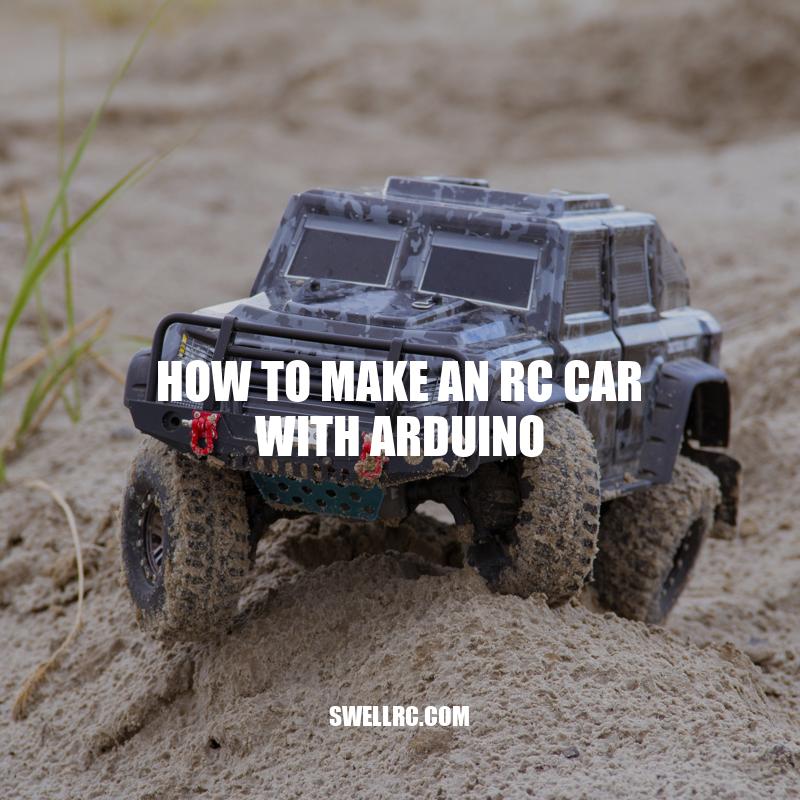How to Make an RC Car with Arduino: A Step-by-Step Guide
Remote control (RC) cars are a beloved hobby for both children and adults, and building your own RC car with Arduino is an exciting way to customize and experiment with your vehicle. Arduino is a popular open-source electronics platform used for creating interactive projects, including robotics and RC cars. Using Arduino in building an RC car offers several advantages, including the ability to incorporate sensors and other advanced features into your vehicle, as well as the opportunity to learn the basics of electronics and programming. And with the availability of various RC car kits and components, it has never been easier to build your own customized RC car that can be controlled via a remote control or even an app on your smartphone. In this article, we will guide you on how to build your own RC car with Arduino, providing step-by-step instructions and tips for creating a fully functioning, interactive vehicle that you’ll be proud to show off.
Setting up the Arduino board
To begin building your RC car with Arduino, you’ll need to set up your Arduino board correctly to ensure it is functioning properly. Here are the steps to follow:
- Select the right Arduino board: Different Arduino boards have varying capabilities, so you’ll want to choose one that is suitable for your project. Some popular options include the Arduino Uno or the Arduino Nano.
- Install necessary software: You’ll need to download and install the Arduino IDE software onto your computer so that you can program your Arduino board. You can download the software from the official Arduino website.
- Connect your Arduino board to your computer: Plug in your Arduino board to your computer with a USB cable.
- Select the correct port: In the Arduino IDE, select the correct port under the ‘Tools’ menu so that you can communicate with the Arduino board.
- Upload code to your Arduino board: Once your Arduino board is connected to your computer, you can start uploading code to the board to program it to perform certain functions.
By following these steps, you’ll be able to set up your Arduino board and start building your RC car in no time.
How to setup an Arduino board?
To setup an Arduino board, follow these simple steps:
- Download and install the Arduino IDE from the official website arduino.cc
- Connect your Arduino board to your computer using a USB cable
- Select the correct board and port in the Tools menu of the IDE
- Write or upload your code to the IDE
- Click on the upload button and wait for the code to be compiled and uploaded to the board
- Disconnect the board from the computer and connect any necessary components to it
For more detailed instructions and troubleshooting tips, visit the Arduino guide on their website.
Building the RC car
Now that you have set up your Arduino board correctly, it’s time to start building your RC car. Here are the steps to follow:
Choosing Your Chassis and Body Components
| Component | Function |
|---|---|
| Chassis | Provides the foundation for your RC car, on which all other components will be mounted |
| Wheels and Tires | Provide traction for the car |
| Motor | Provides power to the car to make it move |
| Battery | Provides power to the motor and other components |
| Radio receiver and transmitter | Allows you to control your RC car wirelessly |
Choosing Your Kit and Assembling the Car
There are several types of RC car kits available, including pre-built, partially assembled, and DIY kits. If you’re a beginner, purchasing a pre-built or partially assembled kit can be a good option to avoid frustration during the assembly process. However, if you’re experienced in building electronics, a DIY kit can allow for the most customization.
Once you have your kit, it’s time to assemble your RC car by following the instructions provided in the kit. Some important things to keep in mind during assembly include making sure all components are securely attached and following the wiring diagram provided in the instructions.
By building your RC car with these components and following the instructions carefully, you’ll be able to create a high-performing RC car that you can control with an Arduino board.
How to Make a Circuit for a RC Car?
To make a circuit for an RC car, you’ll need a few components:
- RC Car kit with motor
- Battery with connector
- ESC (Electronic Speed Control) with connector
- Transmitter and Receiver set
- Wires, solder, and a soldering iron
Here are the steps to make a circuit for an RC car:
- Start by connecting the motor to the ESC.
- Connect the battery to the ESC.
- Connect the ESC to the receiver.
- Plug in the receiver to the transmitter.
- Test your circuit to ensure it’s working properly.
There are plenty of websites, such as RC Planet and HobbyTown, that offer tutorials and products to help you make a circuit for your RC car.
Programming the RC Car
Once you have assembled your RC car, you can now start programming it. Here are some steps to follow:
Learning Basic Programming
To program your RC car using Arduino, you must have a basic understanding of programming languages such as C++ or C. Here are some resources you can use to learn:
- Codecademy: Codecademy offers free online courses in programming languages, including C++ and C.
- Udemy: Udemy offers paid online courses on programming that are more comprehensive than Codecademy courses.
- Arduino Website: The official Arduino website offers tips on how to program Arduino boards.
Programming Your RC Car:
Once you have the basic programming knowledge, you can start programming your RC car using Arduino. Some important things to keep in mind during programming include:
- Creating a new sketch in the Arduino Integrated Development Environment (IDE)
- Knowing the correct syntax to use for your program
- Understanding how to upload code to your Arduino board
Example of Code to Program Movement and Controls:
Here is an example of code that you can use to program the movement and controls of your RC car:
“`
#include
Servo servo_1;
void setup() {
servo_1.attach(9);
}
void loop() {
int angle = map(analogRead(A0), 0, 1023, 0, 180);
servo_1.write(angle);
}
“`
With this code, you can control the movement of your RC car using a joystick or another input device.
Which programming should I learn first as a beginner?
As a beginner, it’s best to start with a programming language that is beginner-friendly and widely used. Here are some options:
- Python: Known for its simplicity and versatility, Python is a popular choice for beginners. It has a large user community and a vast array of libraries and resources.
- JavaScript: Widely used for web development, JavaScript is a good choice for beginners who want to focus on front-end development.
- C#: Developed by Microsoft, C# is a popular language for Windows desktop applications and game development.
There are many resources available to help you learn these languages, including online courses, tutorials, and coding bootcamps like Codecademy and Udemy.
Adding Sensors to Your RC Car
Adding sensors to your RC car can make it perform specific actions or respond to certain conditions. Here are some steps to follow when adding sensors:
Selecting the Right Sensors
The type of sensor you will add depends on the actions or responses you want your RC car to exhibit. Here are some popular sensors you can use:
– Ultrasonic sensors: used for detecting obstacles
– Infrared sensors: used for detecting color or light intensity
– Temperature sensors: used for temperature detection
Connecting the Sensor to Your Arduino Board
To connect the sensor to your Arduino board, follow these steps:
– Identify the pins that the sensor will use
– Connect each pin to the compatible Arduino board port
– Check the sensor’s data sheet for the specific pinout diagram
Programming the Sensor to Your RC Car
After the sensor is connected to your Arduino board, program it to your RC car by following these steps:
– Create a new sketch in the Arduino IDE
– Write the code for the sensor input readout
– Use conditional statements to make the sensor’s output trigger specific actions
Resources for Programming Sensors
Here are some resources that can help you in programming sensors:
– Adafruit: A website that offers articles, tutorials, and user guides for different sensors and other electronics products.
– Sparkfun: A website that offers a wide range of sensors and boards and provides tutorials and project guides.
– Arduino: The official Arduino website offers tutorials on building sensors and how to integrate them into your projects.
How to connect an Arduino to a RC car?
To connect an Arduino to an RC car, you will need the following materials:
- An RC car that you can modify without breaking
- An Arduino board
- A motor controller shield that will match the motor of the RC car
- A battery for the Arduino and another battery for the car, or a battery that powers both
- A remote control with the necessary buttons
Once you have these, follow these steps:
- Detach the control circuitry of the RC car from the motors with a screwdriver
- Solder male headers to the motor controller’s breakout pins
- Connect the motor controller shield to the Arduino, and the battery to the shield
- Upload the custom program code to the Arduino board
- Jumper the necessary pin to the remote’s button
- Attach the modified motor controller to the RC car and the Arduino board, and power them on
There are many online tutorials and videos that can walk you through this process in detail. Try checking out websites like arduino.cc or instructables.com to get started.
Troubleshooting Your DIY RC Car
Building an RC car with Arduino may require some troubleshooting to get it functioning correctly. Here are some common issues that may arise and how to fix them:
Interference and Connection Problems
– Check that all connections are properly secured
– Use shielded cables to reduce electromagnetic interference
– Try moving the car and controller to different locations to reduce interference
Motor Not Running
– Check that the power supply voltage is sufficient for the motor
– Check that the motor connections are positive to positive and negative to negative
– Try replacing the motor with a new one
Programming Issues
– Check your code for any syntax errors
– Verify that your program is properly uploaded to the Arduino board
– Check your wiring and connections for any mistakes
Resources for Troubleshooting
Here are a few resources to help you troubleshoot your DIY RC car before seeking additional assistance:
– Arduino: The official Arduino website offers a troubleshooting section and forum where users can ask questions and get help.
– Instructables: A website that provides step-by-step tutorials and support forums for a range of electronics projects.
– Reddit: A popular online community with dedicated forums for Arduino and DIY projects where users can ask questions and seek advice.
How do you troubleshoot an RC car?
- Check the batteries – make sure they are fully charged and installed correctly, and that there are no loose connections.
- Inspect the motor and gears – make sure they are not stripped or damaged, and that they are properly lubricated.
- Check the remote control – ensure that it is working properly and that the batteries are charged.
- Examine the antenna – make sure it is not damaged or broken, and that it is properly connected to the receiver.
- Inspect the wheels and tires – make sure they are not loose or damaged, and that they are properly inflated.
If you are still having issues with your RC car, there are many websites and forums dedicated to troubleshooting and repairing RC cars, such as RC Groups or RC Universe. You can also check with the manufacturer or local hobby shops for additional support and guidance.
Conclusion
With some basic knowledge of electronics and programming, it is possible to build an RC car with Arduino that can be used for racing or other recreational activities. The process involves selecting the right Arduino board, assembling the car, programming it, and adding sensors for more advanced functionality.
The DIY approach not only offers a fun and creative outlet for personal projects, but it also provides a deeper understanding of how electronics and programming work together. Troubleshooting any issues along the way can also help increase one’s knowledge in these fields.
While there are plenty of resources available to help with the building and programming process, it is important to be patient and expect some challenges. Building a successful RC car with Arduino requires some trial and error but can result in a rewarding end product.
Overall, creating an RC car with Arduino is a fun and educational experience, whether it’s for personal use or to inspire young and budding engineers. With the right components, some patience, and a willingness to learn, it is possible to create a functioning DIY RC car that can provide hours of entertainment.



